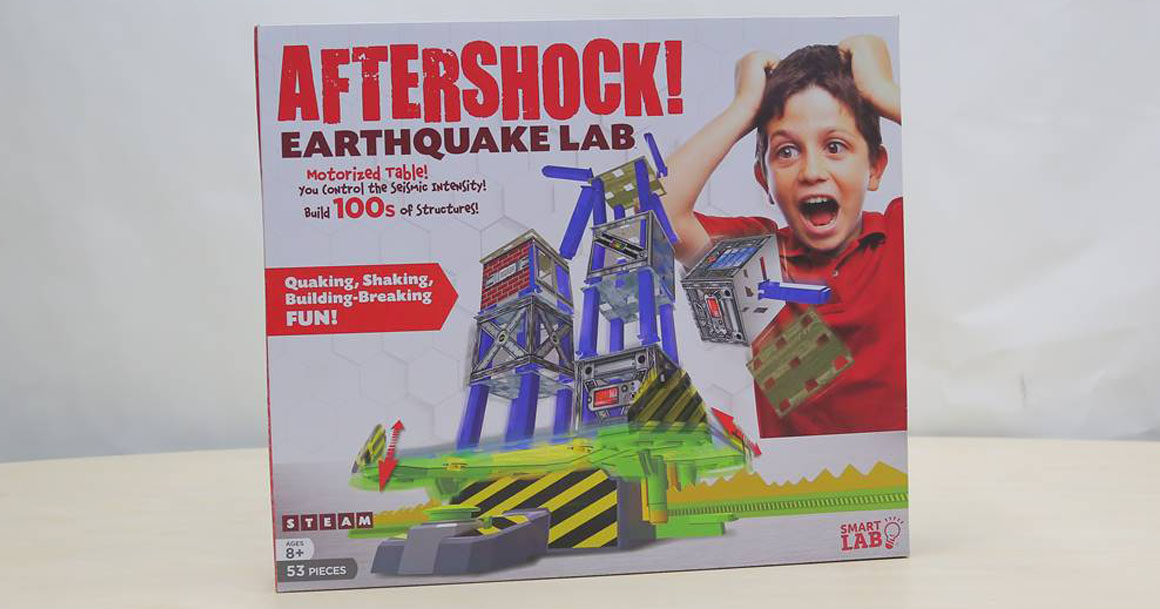前言Introduction
你知道嗎?地球每天發生上萬次地震,縱然大部分是我們察覺不到的,但強烈地震卻會帶來嚴重破壞,令不少人家園盡毀,甚至喪失性命。因此,不少地震頻生的國家透過興建防震建築,以減少人命傷亡和財物損失。
在這個活動中,我們將重温地震的成因與影響,並學習防震建築的設計原理。我們還會將理論實踐,製作防震建築模型及測試它的防震能力﹗
Do you know more than 10 000 earthquakes occur every day? Though some of them can hardly be felt by people, the strong ones are destructive. Therefore, many earthquake-prone countries reduce loss of lives and propertites by constructing shock-proof buildings.
In this activity, we will review the causes and effects of earthquakes and learn the principles of shock-proof buildings. We will then make simple models and test their shock-proof abilities!
地理Geography
地震的成因與影響The causes and effects of earthquakes
STEM 影片STEM Video
地震的成因—板塊移動The causes of earthquakes — Plate movement
在了解地震的成因之前,我們先來重溫板塊移動的概念。
地球的地殼主要由七大板塊組成,它們承載陸地和海洋。兩塊板塊接壤的地方稱為板塊邊界。板塊不是靜止不動的,而是受地幔內的對流帶動,緩慢地移動。
Before we go into the causes of earthquakes, let’s review the concept of plate movement.
The Earth’s crust is mainly made up of seven solid rock pieces called plates that form the land surfaces and ocean beds. The area where two plates meet is known as the plate boundary. Plates are not static, but driven by convection currents in the mantle and move slowly.
板塊主要以三種方式移動:
The plates move in three different ways:
- 地核附近的地幔物質受熱,緩慢地向上升
- 物質在地殼附近冷卻,然後向下沉
- 接近地核的物質再次受熱上升
- 對流帶動上層的板塊移動
- Mantle near the core is heated and rises
- Mantle cools near the crust and then sinks
- Mantle is heated near the core and rises again
- This up-and-down movement forms the convection currents that drives the plates above to move
地震的形成過程The process of earthquakes
板塊移動令板塊邊界承受很大壓力。當壓力超過板塊所能承受的上限時,板塊會突然猛烈震動,甚至斷裂,並將長期累積的能量以地震波的形式釋放出來,令土地劇烈搖晃,引致地震。
了解過地震的形成後,接下來,我們來看看地震如何透過地震波傳遞能量。
When the plates move, pressure builds up along the plate boundaries. When the pressure becomes too large, the plates displace and fracture suddenly. Huge amount of energy is released in all directions in the form of seismic waves, causing an earthquake.
Next, let’s learn how earthquakes transmit energy via seismic waves.
地震傳遞能量的方法How earthquakes transmit energy
波能傳遞能量,但不傳遞物質。因此,地震波將釋出的巨大能量藉由介質的振動往四周傳播,而傳播方式主要分為主波和次波兩種。
Waves can transmit energy without the transfer of matter. As a result, seismic waves transmit the energy released in all directions by the vibrations of medium. There are two main ways of transmission, which are primary wave and secondary wave.
主波:縱波
Primary wave: a longitudinal wave
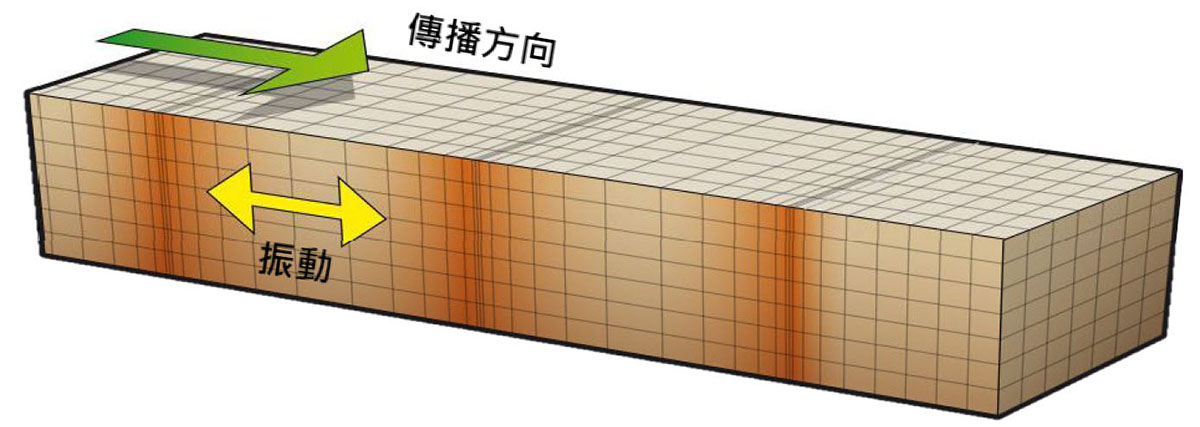
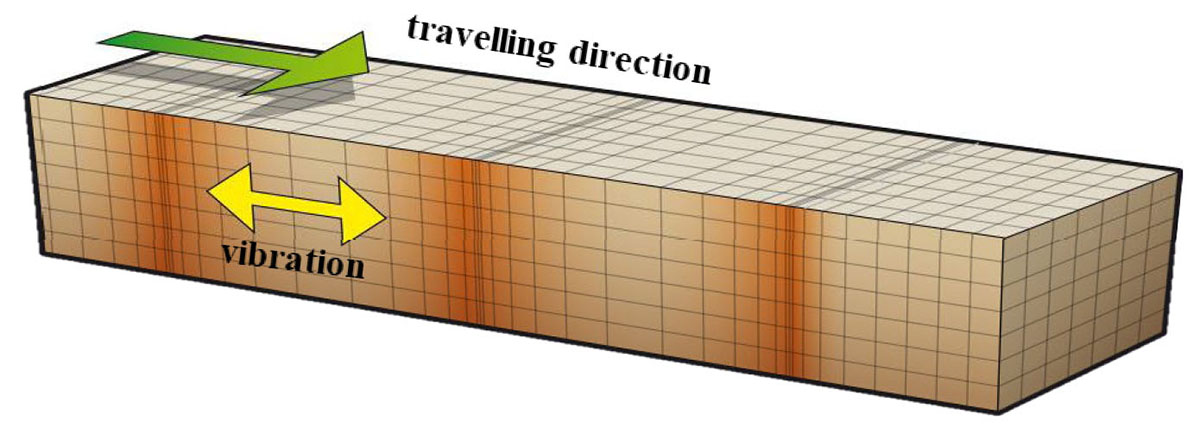
次波:橫波
Secondary wave: a longitudinal wave
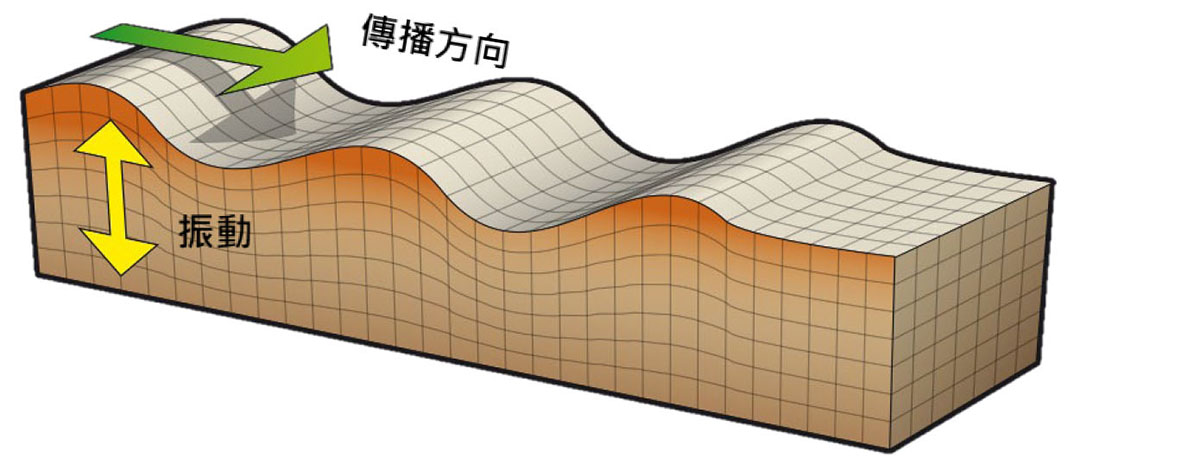
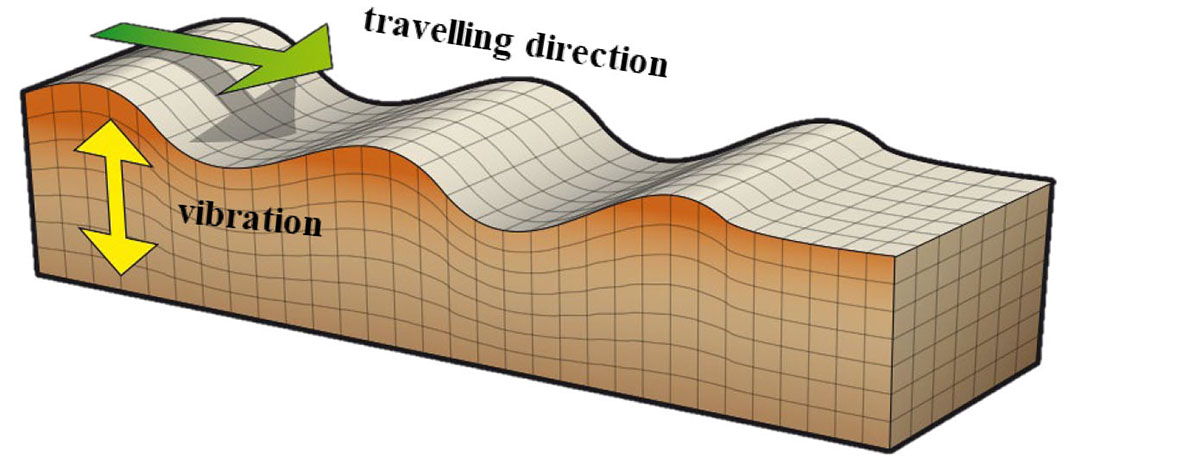
設計及製作—震台Design & DIY—Vibration table
現在,我們將使用以下材料,按步驟製作一個「震台」,以模擬地震的發生。
Now, we will use the materials below and follow the steps to build a ‘vibration table’ to simulate an earthquake.
Materials:
| Foam board | 2 |
| Bouncing balls | 6 |
| Rubber bands | 3 |
製作步驟:
Steps

1. 預備一塊發泡膠板。
1. Prepare a piece of foam board.

2. 在發泡膠板上放上彈彈波。
2. Put the bouncing balls on the foam board.

3. 在彈彈波上放置另一塊發泡膠板。
3. Put another foam board on the bouncing balls.

4. 用橡皮圈將發泡膠板和彈彈波固定。完成!
4. Use rubber bands to fix the foam boards and bouncing balls. Done!
地震的強度及影響The strength and effects of earthquakes
我們用黎克特震級來表示地震的強度。地震震級越高,釋放的能量越大,破壞力也越大。
We use Richter scale to measure the magnitude of an earthquake. The higher the magnitude, the more energy is released and the larger the damage caused.
地震的影響主要分為直接影響和次生影響。直接影響指地震帶來的即時破壞,包括建築物倒塌、交通及電力中斷等。次生影響則是指由地震衍生出來的破壞,例如火災和海嘯等。
The impacts of earthquakes can be divided into primary effects and secondary effects. Primary effects are the immediate and direct destruction caused by earthquakes, such as collapse of buildings and damage of roads. Secondary effects are the damage caused by primary effects, such as fires and tsunamis.
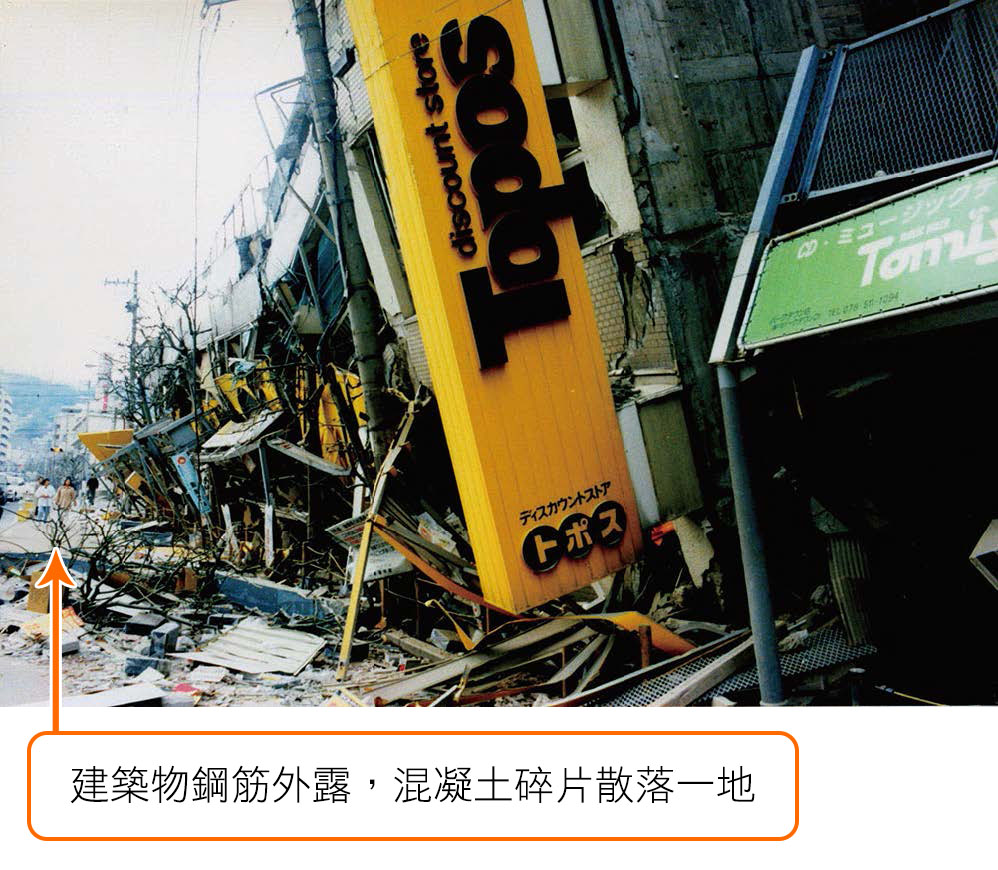 ▲ 1995年神戶大地震導致大量建築物倒塌
▲ 1995年神戶大地震導致大量建築物倒塌
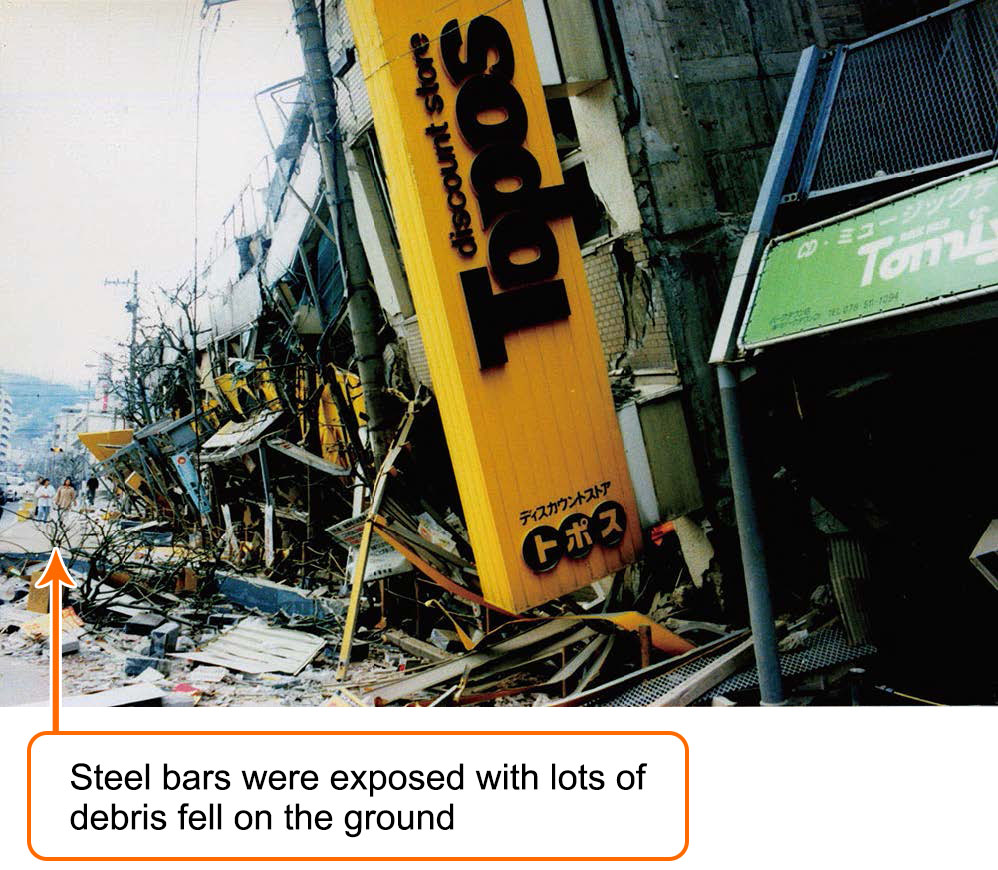 ▲ Buildings collapsed in the 1995 Kobe Earthquake
▲ Buildings collapsed in the 1995 Kobe Earthquake
建築物倒塌是導致地震中人命傷亡的主要原因之一。因此,不少地震頻生的國家規定建築物須符合防震標準,例如日本的高樓大廈必須能夠抵禦7級以上的地震。接下來,我們將學習3種常見的抗震設計原理和相關例子,並動手製作防震建築模型。
Collapse of buildings is a major cause of deaths and injuries in earthquakes. As a result, many earthquake-prone countries require buildings to meet shock-proof standards. For example, the tall buildings in Japan must be able to withstand earthquakes of magnitude 7 and above. In the following section, let’s learn the basic principles of shock-proof buildings and related examples. Then we will make our own models.
科學Science
防震建築的基本原理Basic principles of shock-proof design
1. 建築方法1. Construction method
採用堅固和具韌性的建築物料可提高建築物承受地震波的能量。此外,應用「三角形穩定性」或加入交叉形的撐桿也有助鞏固建築物。
Strong, ductile materials are used to construct buildings that can withstand the shock of earthquakes. The buildings can be made more stable by applying ‘triangle stability’ or by adding cross-braces to the structure.
一般建築方法
Conventional method
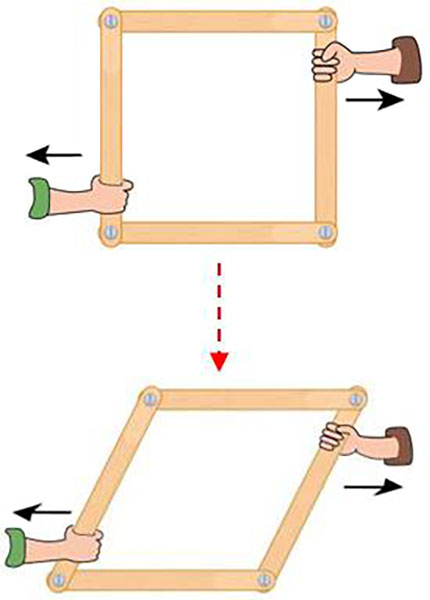
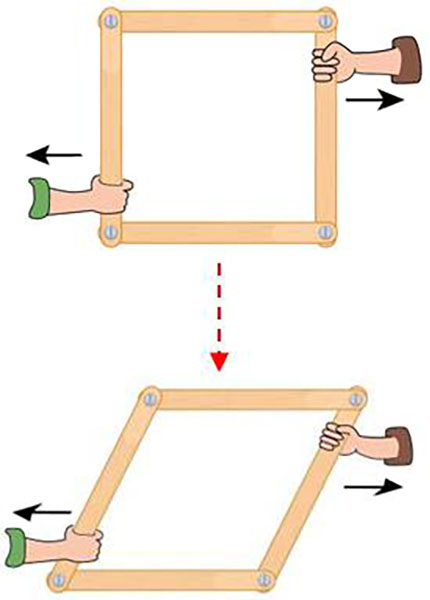
容易變形
Transform easily
應用「三角形穩定性」
Applying ‘triangle stability’
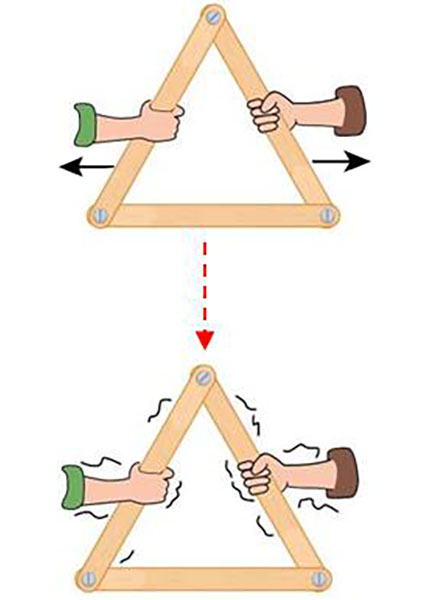
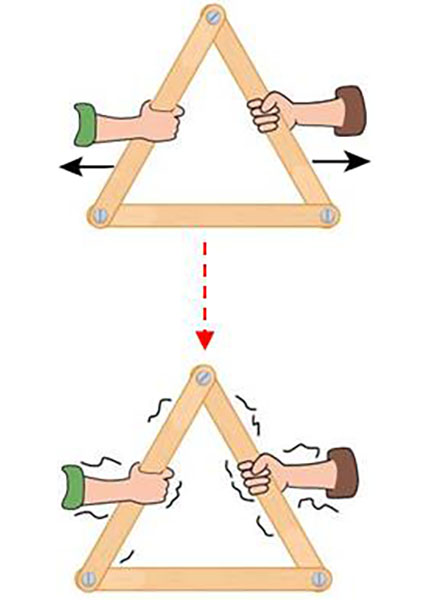
不容易變形
Difficult to transform
加入交叉形的撐桿
Adding cross-braces
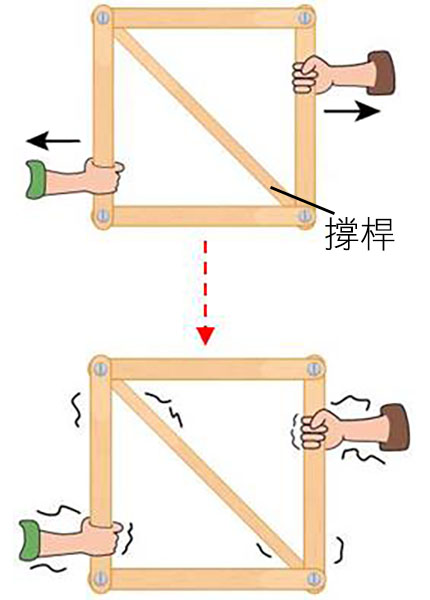
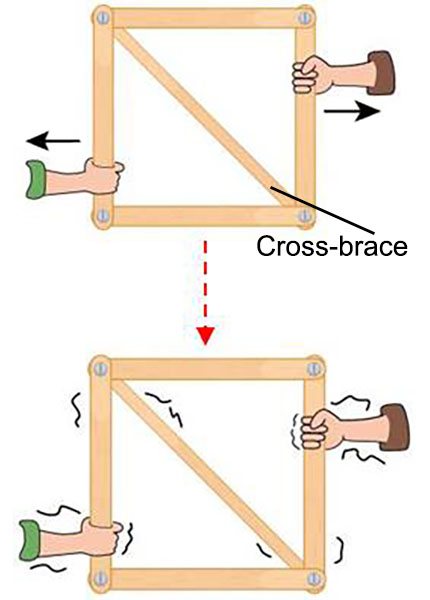
不容易變形
Difficult to transform
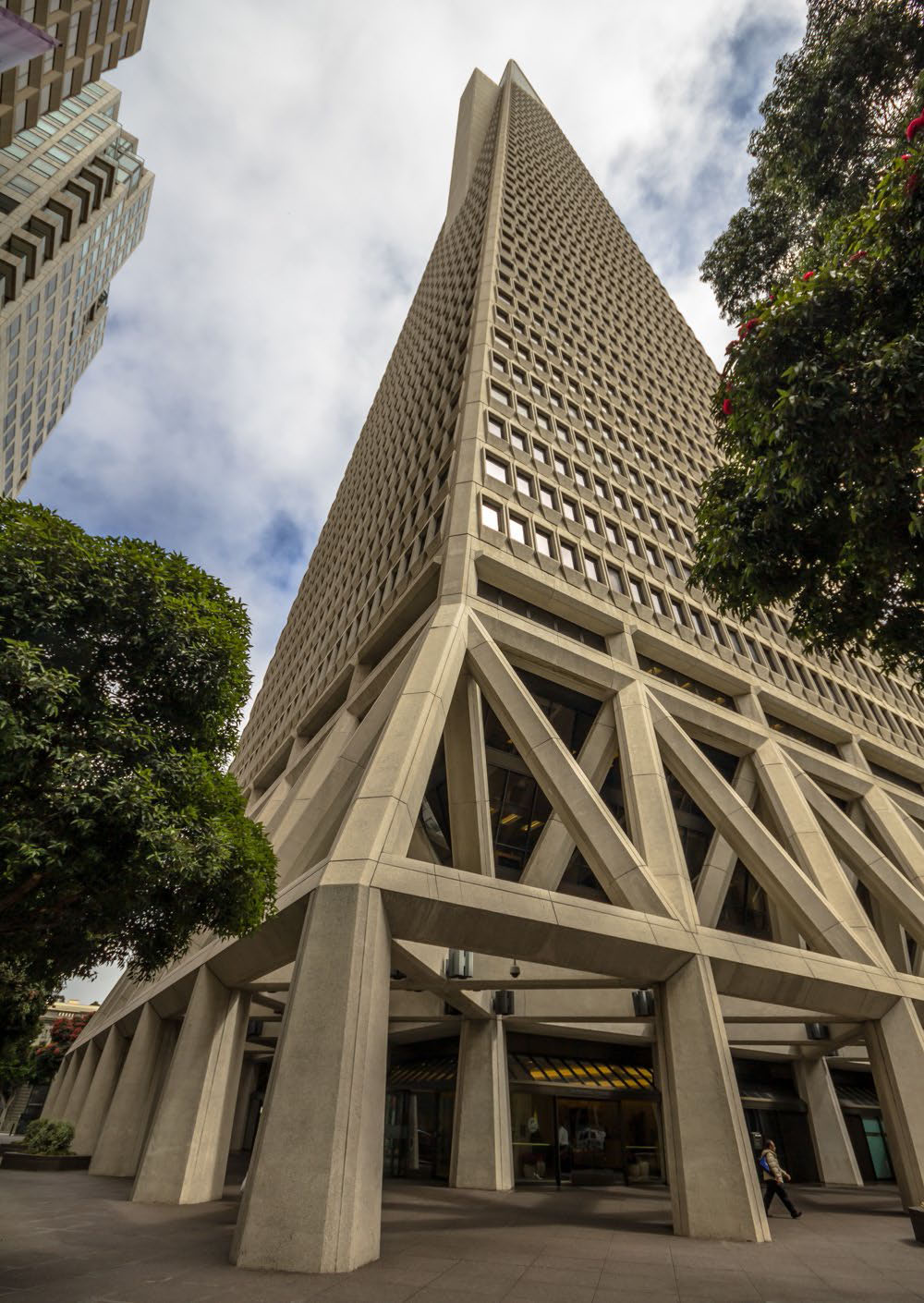 ▲ 美國三藩市的泛美金字塔大廈是一個加入交叉形撐桿的例子
▲ 美國三藩市的泛美金字塔大廈是一個加入交叉形撐桿的例子
 ▲ The Transamerica Pyramid in San Francisco is an example of adding cross-braces
▲ The Transamerica Pyramid in San Francisco is an example of adding cross-braces
設計及製作Design and DIY
現在,我們會利用以下材料,模擬地震發生時,一般建築物和加入撐桿的建築物的搖晃情況。
Now, we can simulate how buildings with and without cross-braces vibrate during an earthquake. Follow the steps below to make simple models.
所需物料︰
| 絨毛條 | ~20條 |
| 發泡膠球 | ~20個 |
| 膠水 | 1枝 |
| 震台 | 1個 |
Materials:
| Pipe cleaner | ~20 |
| Foam ball | ~20 |
| Glue | 1 |
| Vibration table | 1 |
製作步驟:
Steps:
用絨毛條和發泡膠球作為支架,製作兩座建築物,其中一座加上「斜邊」支撐。
Use pipe cleaners and foam balls to make the frames of two buildings, one of them with added diagonal beams for support.
想一想Think about
Which building vibrates less vigorously when an earthquake occurs?
2. 底部隔離2. Base isolation
底部隔離的原理是在建築物底部安裝隔震裝置,以隔開建築物底部與地面。隔震裝置以彈性物料製造,地震發生時,物料會振動並吸收部分來自地震波的能量,以減少傳遞至建築物的能量,並減低地震對建築物造成的破壞。
Base isolation separates the base of a building from the ground with base isolators composed of flexible isolation units. When an earthquake hits, the isolation units vibrate and absorb some of the energy of the seismic waves. This reduces the energy transferred to the building, keeping it stable and minimising the damage to the structure.
一般建築物
Conventional building
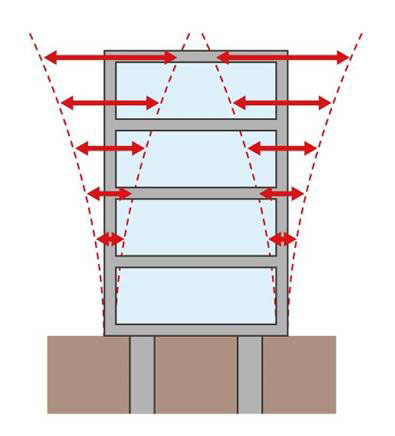
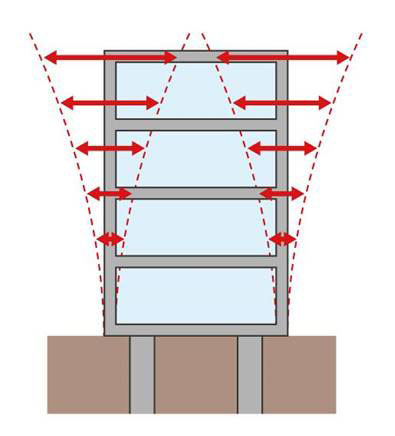
建築物振動劇烈,並受到嚴重破壞
Building vibrates and may become damaged
加入隔震裝置的建築物
Seismic isolation building
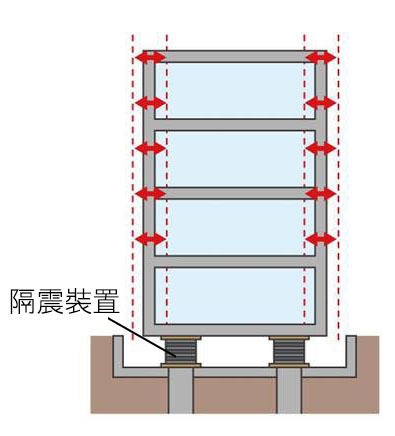
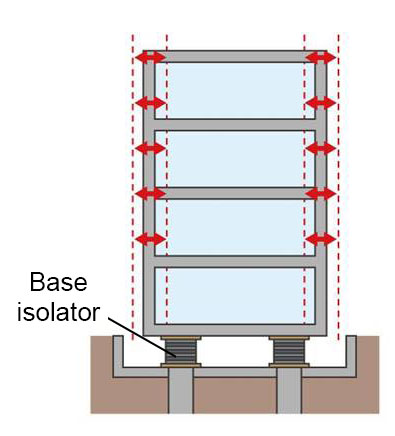
振動較小
Vibration is reduced
設計及製作Design and DIY
現在,我們會利用以下材料,模擬地震發生時,一般建築物和加入隔震裝置的建築物的搖晃情況。
Now, we can simulate how buildings with and without base isolation vibrate during an earthquake. Follow the steps below to make simple models.
所需物料︰
| 木條 | ~20枝 |
| 波子 | ~8粒 |
| 紙盒 | 2個 |
| 裝有顏色水的水杯 | 2個 |
| 震台 | 1個 |
Materials:
| Wooden stick | ~20 |
| Marble | ~8 |
| Paper box | 2 |
| Glasses with coloured water | 2 |
| Vibration table | 1 |
製作步驟:
Steps:
想一想Think about
Which building vibrates less vigorously when an earthquake occurs?
3. 阻尼效應3. Damping
阻尼效應和底部隔離的原理相似,主要透過一個巨大的球體裝置吸收地震波的能量。例如,台北101大樓頂層的阻尼器在地震時能作出小幅度的搖擺,以減低建築物的振動。
Similar to base isolation, damping reduces the damage of buildings mainly by energy absorption. For example, the skyscraper Taipei 101 has a massive damper near the top floors to absorb energy of seismic waves. It swings slightly to counteract the vibrations of the building.
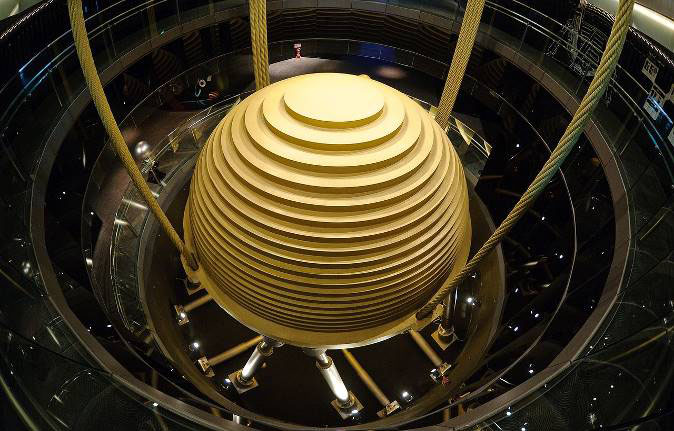 ▲ 台北101大樓的阻尼器
▲ 台北101大樓的阻尼器
 ▲ The damper in Taipei 101
▲ The damper in Taipei 101
設計及製作Design and DIY
現在,我們會利用以下材料,模擬地震發生時,一般建築物和加入阻尼器的建築物的搖晃情況。
Now, we can simulate how buildings with and without a damper vibrate during an earthquake. Follow the steps below to make simple models.
所需物料︰
| 木條 | ~60條 |
| 幼繩 | 1條 |
| 膠水 | 1枝 |
| 砝碼 | 1個 |
| 震台 | 1個 |
Materials:
| Wooden stick | ~60 |
| String | 1 |
| Glue | 1 |
| Weight | 1 |
| Vibration table | 1 |
製作步驟:
Steps:
想一想Think about
Which building vibrates less vigorously when an earthquake occurs?
比賽Competition
防震建築設計比賽Shock-proof building design competition
現在,同學可利用並改良上述防震建築的原理,製作防震模型。老師可根據以下準則評核學生的設計,以找出防震能力最佳的模型。
Now, let’s have a competition in class. By applying and modifying the shock-proof principles, design your own shock-proof building. Your work will be evaluated based on the following grading rubric.
|
評核準則
Assessment criteria
|
水平
Quality of work
|
|
優異
Excellent
|
良好
Good
|
普通
Average
|
尚可
Satisfactory
|
差劣
Poor
|
|
建築物的防震效能
Shock-proof ability of the building
|
5 |
4 |
3 |
2 |
1 |
|
建築物的大小與高度
Size and height of the building
|
5 |
4 |
3 |
2 |
1 |
|
製作成本
Cost of the building
|
5 |
4 |
3 |
2 |
1 |
|
物料的應用
Use of materials
|
5 |
4 |
3 |
2 |
1 |
|
外觀及創意
Appearance and creativity
|
5 |
4 |
3 |
2 |
1 |
|
整體
Overall quality of work
|
5 |
4 |
3 |
2 |
1 |
附加資源Additional resources
Arduino Science JournalArduino Science Journal
我們可使用Arduino Science Journal來檢測建築物的振動,以測試建築物的防震效能。
We can use Arduino Science Journal to detect the vibration of buildings in order to test their shock-proof abilities.
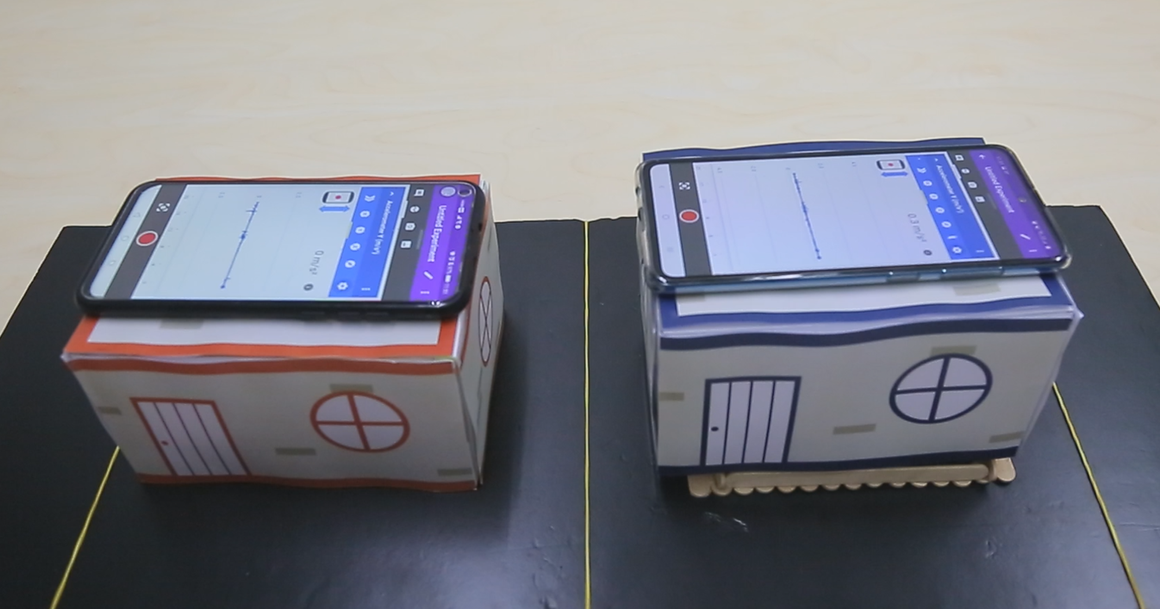
玩具教材Educational Toy
這盒玩具可用來模擬地震,想了解其玩法和模擬效果,請立即觀看我們的「開箱」影片!
This toy can be used to simulate an earthquake. If you want to know more about the toy and the simulation result, click into our ‘unboxing’ video now!
